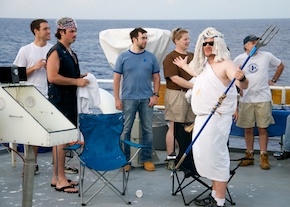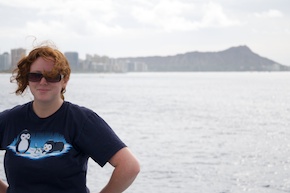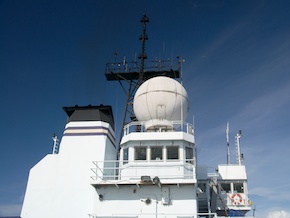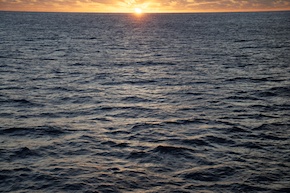The R/V Thomas G. Thompson left Honolulu on November 5, 2011 heading toward the Western Pacific. This expedition journal was written by cruise participants and uploaded about once per weekday, depending on internet availability.
November 19, 2011: Unplugged

Increased social efforts? (Credit: Will Koeppen)
Forty-two days on a ship without constant access to television, internet, or mobile apps; could you survive? Surely with increased social efforts and a few magazines this too is possible. It is not easy for a generation so accustomed to technological convenience to endure this, but the students from Kutztown seem to be surviving, even thriving.
Internet access and availability vary on different research vessels. Some vessels allow access to the internet on personal laptops, and others are more restricted. On the R/V Knorr, a ship operated out of Woods Hole Oceanographic Institution in Massachusetts, everyone was granted internet privileges on their personal computers. However, because we had limited bandwidth, this meant that if a lot of people were surfing, the internet would be very slow. On board the R/V Thompson we can surf the web on public terminals with limited bandwidth. There are four of these public computers on board, two designated for the ship’s crew and two in the lab and science areas used primarily by the science party. Everyone on board also has access to shared network storage on the ship, where we can find scientific data, atmospheric information, the ship’s track, and photos uploaded by the crew and science party.

iPhone-slinging introvert (Credit: Will Koeppen)
As an iPhone-slinging introvert, life on a ship without 3G, 4G, or any other G data network can be hard to adjust to. While at home (on the mainland) I enjoy keeping caught up on news and events with my mobile applications as well as constantly having access to my email and Facebook. At sea, it is easy to feel disconnected from the world, a justified feeling since we are, in fact, geographically and sometimes technologically (i.e. internet) very disconnected. On board the Thompson, television watching and mobile app entertainment are replaced with cribbage, Munchkin, card games, Ping Pong, sitting in the sun on the “steel beach”, and DVDs. Social activities are the norm whether you are feeling social or not, so it is a good place to work on your communication and people skills. There are 49 people on board this ship and all are confined to about a 275-foot long stretch of living and working space.

Deathstar-brand internet (Credit: Will Koeppen)
With only four public computers and that many people it can be difficult sometimes to find online time. There is also an unwritten, unspoken code of ethics when it comes to surfing. The general rule is don’t spend seven hours on Facebook while a line of irate crew and science members grumble in the background. I have been able to pretty regularly check my email and spend about thirty minutes per day online. I try to keep my time to a minimum, but unfortunately this means I have not had a lot of time to write my friends and family at home. Having just graduated in May from the University of Maine with my Bachelor’s degree, I fortunately do not have to maintain academic studies while on this research cruise. The Kutztown students are very dedicated managing not only a full academic course load but also working full-time, seven days a week watchstanding, and contributing towards this blog. Although, I do not have coursework to focus on, I have other matters to attend to including applications for graduate school, scholarships, internships, and employment. Most of these require online time to send paperwork and download documents so it has been a challenge. Downloading is restricted due to bandwidth and simple word documents of a few megabytes in size can take 15-20 minutes to download.

One option (Credit: Will Koeppen)
A recent application for a scholarship required an interview just a few days ago. I participated in this interview via Skype while on the ship and had to get special permission from the chief scientist to grant my laptop temporary internet access so I could log on. I tried to find a quiet, isolated place to carry out the interview. There are, however, not many of these places on a ship that is operating 24 hours a day. I did eventually find a small office space and, after some technical glitches including the microphone and webcam malfunctioning, I began the interview relatively smoothly. Unfortunately I forgot to put a “do not disturb” sign on the door, and halfway through the interview someone came in asking me if I wanted the door closed (it was already closed to begin with). I hastily explained that I was in the middle of an interview and they evacuated swiftly thereafter. Near the end of the interview someone began welding, needlegunning, or conducting some other kind of noisy, metallic activity immediately outside of this office space. Overall, I would still say my interview went well, or so I hope. Privacy and quiet: both these things are quite difficult to come by while at sea, unless you like swimming. ♦
